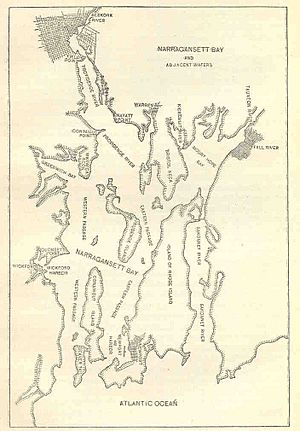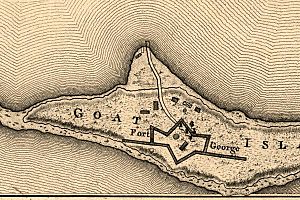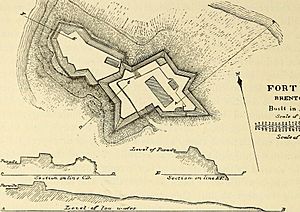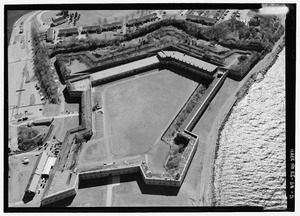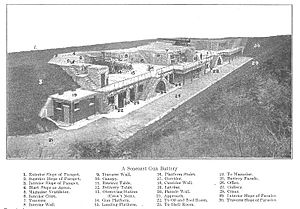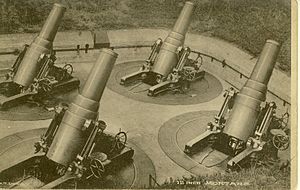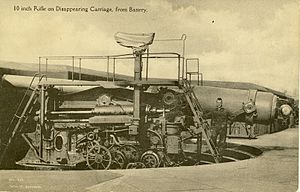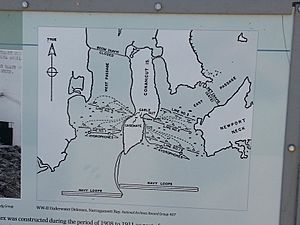Harbor Defenses of Narragansett Bay facts for kids
Quick facts for kids Harbor Defenses of Narragansett Bay |
|
|---|---|
| Active | 1895-1950 |
| Country | |
| Branch | United States Army Coast Artillery Corps |
| Type | Coast artillery |
| Role | Harbor Defense Command |
| Part of |
|
| Garrison/HQ | Fort Adams, Newport, Rhode Island |
| Motto(s) | Hope |
| Mascot(s) | Oozlefinch |
The Harbor Defenses of Narragansett Bay was a special military command in the United States Army Coast Artillery Corps. Its job was to protect the coast of Narragansett Bay and Rhode Island. This defense system was active from 1895 to 1950. It included large forts and hidden underwater minefields. The command started around 1895 and changed its name a few times. It became the "Coast Defenses of Narragansett Bay" in 1913 and then the "Harbor Defenses of Narragansett Bay" in 1925.
Contents
Exploring Narragansett Bay's Geography
Narragansett Bay is a large bay in Rhode Island. It has two big islands in its southern part: Aquidneck Island to the east and Conanicut Island to the west. These islands divide the bay into three main waterways.
The western waterway is called the West Passage. It runs between Conanicut Island and the mainland. The middle waterway is the East Passage, located between Conanicut and Aquidneck Islands. The city of Newport is on Aquidneck Island. Because Newport has a safe harbor, the East Passage was the most important area to protect with forts for a long time.
The eastern waterway is called the Sakonnet River. It is between Aquidneck Island and the mainland. This part of the bay is narrow and shallow, so it wasn't heavily fortified until World War II.
A Look Back at Rhode Island's Forts
Rhode Island has a long history of building forts to protect its coast.
Early Forts and Battles
Colonial Period Defenses
Before the American Revolution, Rhode Island had one main fort. It was called Fort Anne, later Fort George, and finally Fort Wolcott. This fort was on Goat Island in Newport harbor. It started as a simple dirt battery in 1700 and grew into a large stone fort with 50 guns by 1727.
Another early defense was Brenton's Battery in Newport. This spot later became the famous Fort Adams. It had guns as early as 1641 and was rebuilt in the 1750s.
Revolutionary War Fortifications
When the Revolutionary War began in 1775, American patriots took over Fort George. They renamed it Fort Liberty. They added more guns and soldiers. Patriots also built other batteries in Newport, like one at Easton's Point. This battery helped protect the town from British ships.
On Conanicut Island, patriots built the Dumpling Rock Battery, also known as Fort Brown or Fort Conanicut. They also fortified the West Passage with Beaver Tail Fort and the Conanicut Battery.
In December 1776, the British captured Newport. They took over the forts and stayed for three years. In 1778, French forces tried to help the Americans take Newport back. They fought the Battle of Rhode Island but were not successful. The British left Newport in October 1779. Patriots then reoccupied Fort George, renaming it Fort Washington.
In 1780, French troops led by Count Rochambeau arrived in Newport. They built new forts, like Fort Chastellux. A French map from this time shows many forts and batteries around Newport. A year later, the French troops left Rhode Island to join Washington's army. They helped win the war at Yorktown.
Forts After the Revolution (1783-1812)
After the Revolution, Newport received new forts. These were part of the "first system" of US fortifications. Newport was seen as a very important coastal defense spot. Major Louis de Tousard, a French engineer, designed four new forts. The most important was the first Fort Adams on Brenton's Point. It had 17 guns.
Other forts included Fort Hamilton on Rose Island, a rebuilt Fort Dumpling on Conanicut Island, and Fort Greene at Easton's Point. Fort Adams was finished in 1799. Fort Dumpling was done in 1798. Fort Greene was mostly finished by 1800. Fort Wolcott was also updated with 38 guns.
Around 1806, fears of war with Britain led to more fort repairs. Rhode Island was not attacked during the War of 1812. State troops guarded Fort Adams and Fort Greene.
Forts from 1816 to 1890
After the War of 1812, the US decided to build bigger, stronger masonry forts. Newport was chosen for one of the largest forts ever built in the United States: the new Fort Adams. This fort was designed by Simon Bernard and Joseph Gilbert Totten. Construction began in 1825 and finished in 1858. It was designed to be very strong against land attacks. By 1854, it had 200 guns and could hold over 400.
During the Civil War, Fort Adams was an important military center. It even hosted the United States Naval Academy for a few months. New defenses were also built on Dutch Island to protect the West Passage.
The Civil War showed that old masonry forts could be damaged by new, powerful cannons. So, in the 1870s, Fort Adams was updated with larger, more modern guns called Rodman guns. New earth-protected positions were built for some of these huge guns.
In 1869, the Naval Torpedo Station was founded on Goat Island. This became a key center for developing torpedoes. Later, Naval Station Newport and the Naval War College were established nearby. These naval facilities grew in importance, making their protection even more vital.
The Endicott Period: Modernizing Defenses
In 1885, a special group called the Board of Fortifications suggested building completely new coast defenses. Construction began in 1897. New forts were built to protect Narragansett Bay. Two hidden underwater minefields were also placed in the East and West Passages.
For the East Passage, new batteries were built at Fort Wetherill and Fort Adams. For the first time, the West Passage was well-defended with three new forts: Fort Getty on Beaver Head, Fort Greble on Dutch Island, and Fort Kearny on the mainland. Fort Wetherill was the largest of these new forts. It also had facilities for planting and storing mines.
These new forts had powerful weapons. Fort Wetherill had large 12-inch and 10-inch guns. Fort Adams had 12-inch mortars and 10-inch guns. Fort Greble had 10-inch guns and 12-inch mortars. Fort Getty had 12-inch guns. Many of these guns were on "disappearing carriages." These carriages would pop up to fire and then drop back down, hiding the gun from enemy ships. Each fort also had smaller 3-inch guns to protect the minefields.
The Spanish–American War started in 1898. Many of the new forts were not yet finished. So, some faster-firing guns were quickly set up. Fort Adams received an 8-inch gun and two 4.72-inch Armstrong guns. Fort Getty received a 6-inch Armstrong gun.
Another fort, Fort Mansfield, was built in Westerly, Rhode Island. It was meant to guard the strait to Fishers Island. However, it was found to be vulnerable and was later abandoned.
World War I and Beyond
When the US entered World War I, many changes happened. The Coast Artillery was chosen to operate most of the heavy artillery for the war. Soldiers from the forts were sent to fight in Europe. Some guns were removed from the forts to be used as railway artillery or field guns.
After World War I, antiaircraft batteries were added to Fort Adams, Fort Wetherill, and Fort Greble. These batteries had 3-inch guns to shoot down enemy planes. In 1920, many older guns were removed from service.
In 1925, the commands were renamed "Harbor Defenses." The 10th Coast Artillery and the 243rd Coast Artillery (from the Rhode Island Army National Guard) were the main units protecting Narragansett Bay. In 1936, some 10-inch guns from Fort Wetherill were moved to another fort in New York.
World War II Defenses
During World War II, many new buildings were quickly constructed. The Army decided to replace older heavy guns with powerful 16-inch guns. The main defense points for Narragansett Bay became Fort Church and Fort Greene. Each of these forts received two huge 16-inch guns, protected inside concrete bunkers called casemates. Fort Church also had a rare battery of two 8-inch guns.
New 6-inch gun batteries were also built. These guns were often older ones that had been stored since World War I. Three such batteries were built in Narragansett Bay.
In 1942, 155 mm (6.1 inch) guns were quickly set up at key points. These guns were towed and placed on circular concrete platforms. As new defenses were built, most of the older guns from the Endicott era were removed or scrapped by 1944.
New 90 mm guns were also deployed. These were "dual-purpose" guns, meaning they could shoot at both surface ships and aircraft. Five of these batteries were set up around Narragansett Bay. The US Navy also helped protect the bay with nets and submarine-detecting systems.
Some of the Rhode Island forts, like Fort Getty, Fort Greble, and Fort Kearny, served as POW camps during World War II.
After World War II
After the war, it became clear that traditional gun defenses were no longer needed. They were scrapped by 1948. In 1950, the Coast Artillery Corps was dissolved. Today, the Air Defense Artillery continues some of its traditions.
In the 1950s, Nike missile sites were built around Providence, but not on the old fort locations. These missile sites were deactivated around 1972.
What Remains Today
Many of Rhode Island's old forts can still be visited today.
Fort Adams is part of Fort Adams State Park. You can take guided tours in the summer. Efforts have been made to clear overgrowth from the fort. Some of the old officers' quarters, like the Eisenhower House, are still there.
Fort Wetherill is in Fort Wetherill State Park. You can explore many parts of the batteries, though some are fenced off. There are also interpretive plaques around the well-preserved mine support buildings.
Fort Getty is now a campground. Most of its old batteries are buried. The Conanicut Battery is a public park with ruins from the British occupation.
Fort Burnside is now Beavertail State Park. You can see the old 6-inch and 3-inch batteries, though they are overgrown.
Fort Greble is well-preserved, but you need a boat to get to Dutch Island.
The Artillery Company of Newport still exists as a historical reenactment group. Their armory in Newport has a museum open to the public.
Fort Kearny is now part of the University of Rhode Island. The batteries are well-preserved, and some have been converted into offices.
Fort Varnum is now a training institute for the Rhode Island Army National Guard. It is well-preserved but not usually open to the public. It has World War II gun emplacements and old "fire control cottages."
Fort Greene had three separate areas. The East Reservation is now an Army Reserve Center. The West Reservation is part of Fishermen's Memorial State Park and includes Battery 109 and a plotting room bunker. The South Reservation is near Point Judith Light.
Most other forts in Rhode Island have been demolished or buried. Parts of Fort Hamilton on Rose Island remain. Fort Wolcott is completely gone, but a plaque on Goat Island remembers it. Fort Church's batteries are on private property and are buried or built over.
Symbols and Meaning
The Harbor Defenses of Narragansett Bay had its own special symbols, called a coat of arms.
- Shield: The top half of the shield is red, representing artillery. The bottom half is blue, like the Rhode Island state flag, which has a gold anchor on blue. The wavy line between the colors looks like battlements, showing fortifications. On the red part is a gold sundial-compass, a symbol of Roger Williams, who founded Rhode Island. On the blue part is a gold fleur-de-lis, which reminds us of the help the French gave during the American Revolution.
- Crest: The crest shows two gold crossed cannons supporting the blue anchor of Rhode Island.
- Motto: The motto is "Hope," which is also the motto of Rhode Island.
- Symbolism: The anchor represents stability and strength.
- Background: This coat of arms was first approved in 1919 for the Coast Defenses of Narragansett Bay.


